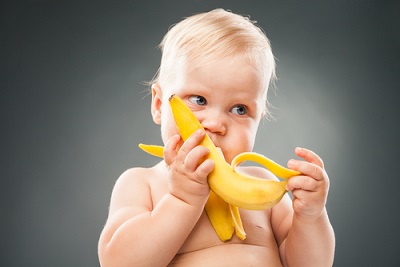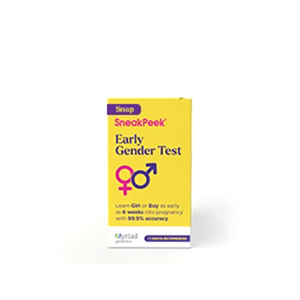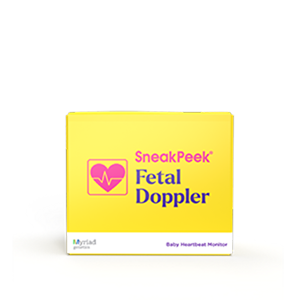Published on February 7th, 2022 and Updated on January 15th, 2024
Check out SneakPeek Gender Test to find out your baby’s gender as early as 6 weeks at over 99% accuracy1!
Of the stages of infant development, transitioning to purees like baby food and even beyond to solids may be one of the most exciting. From absorbing new communication cues from your baby to having her participate in pasta night with you, a host of new milestones can come from her perch on the highchair. If you’re like many parents, you may wonder when can this start? In other words, when can babies eat purees and solid food?
In this guide, we’ll look at when in your baby’s development you can begin transitioning her from liquids to pureed food to solid food, as well as how you can encourage her to meet a brave new world of food with gusto.
When To Feed Your Baby Baby Food & Purees
When can babies eat baby food?
According to the American Academy of Pediatrics, you should be in the clear to start having your baby try baby foods around the 6-month mark. This is the beginning of what’s known as the complementary feeding period, when infants can be introduced to baby foods, purees, and fortified wheat, oat, or rice cereal.
From a nutritional perspective, there’s no need to introduce complementary foods to your child before 6 months old. Breast milk, in particular, is a near-perfect food for your baby with a complete nutritional profile that assists with gut health and the development of a robust immune system, so there’s no need to start baby foods earlier than this.
How To Know If Baby Is Ready For Baby Food
There’s an important physiological reason why 6 months is the best time to begin introducing your baby to complementary baby foods, fortified cereals, and purees.
Babies are born with an extrusion or tongue-thrust reflex—an involuntary movement of the tongue towards objects entering the mouth. This reflex makes it easier for them to latch onto a bottle or nipple, but tends to make feeding and swallowing difficult (and regurgitation a whole lot easier—as your spit-up bib well knows).
At 4 to 6 months, the extrusion reflex begins to wear off, setting the stage for your baby to learn how to move foods from the front to the back of her mouth, rather than simply drink from a bottle. To determine whether your baby is ready to enter the brave new world of purees, you’ll also want to look for the following developmental signals:
- Motor control – Babies who can go from lying down to sitting up on their own may have enough motility to sit up straight in a highchair. Similarly, babies who can control the orientation of their head and neck will be able to ingest purees more safely.
- A desire to eat – If your baby is excitedly leaning forward and opening wide when it’s feeding time, she’s ready to level up to more diverse food sources.
- Mouthing and grabbing – If your baby is eagerly reaching out for food (rather than simply crying with no indication of what she wants), it’s a positive sign that she’s developing awareness of food and how to eat properly.
When To Feed Your Baby Solid Food
Purees are one milestone, but what about solid foods like bananas, strawberries, and Cheerios? After perusing purees, you may be wondering, when can babies eat solid food?
Before you break out the peas and carrots, know that every dietary transition should be as gradual as possible—which means incrementally introducing your baby to more solid textures.
First, introduce soft solid foods at least a few weeks after your little one has transitioned to purees. This provides time to get used to the new texture before another change!
When you do introduce solid foods, the below are “solid” choices:
- Banana
- Avocado
- Squash
- Sweet potato
- Peas
At the beginning of this phase, you can serve these foods mixed with water, breastmilk, or infant formula (cow’s milk should not be introduced until age one) to create a smoother texture. Just remember: any tough foods (like sweet potato) must be boiled, baked, or steamed until soft enough for your baby to gum.
How To Introduce Your Baby To Solid Food
Your baby should be ready to start munching on solid finger food at 7-11 months old. Around this time, there’s a whole new pyramid of food for your baby to explore. Here are some tips to help you get started with introducing solids:
- Go one at a time – A major concern with infant feeding is exposing your little one to a potential food allergy. Letting your baby try foods one at a time, and waiting 3 to 5 days before introducing another new food, is the best way to identify whether or not a food is prompting any adverse reactions. Some common allergens for infants include dairy, soy, fish, and eggs. For more information on eggs, check out our article, “When Can Babies Eat Eggs?”
- Know the no-no’s – While introducing new foods can be exciting, some foods remain on the no-no list for babies. Grapes, hot dogs, and any sticky, slippery, or hard foods (for instance, nuts) are never a good idea to give your baby as they can be a choking hazard.
- Serve the rainbow – According to the American Academy of Pediatrics, serving your baby a variety of foods may reduce his likelihood of becoming a picky eater later on. Not sure where to start? While there’s no particular order for solid food introduction, consider starting with green veggies, like peas and broccoli, before moving onto more colorful and sweet veggies, like sweet potato, and fruits, like banana. This way, your child can develop a taste for vegetables and healthy food before being treated to sweeter solids.
- Explore (but keep it bite-sized) – Once you’ve introduced veggies and fruits, you can pretty much offer your little foodie anything you would eat yourself as long as it’s not on the no-no list, it’s prepared properly, and it’s cut in small pieces, enough for little mouths to handle. This means you can let your baby sample soft, pasteurized cheese when you’re preparing your next cheese board, chopped pasta when it’s pasta night, or even diced meats like skinless chicken or hamburger when you’re having a family cookout. Be sure to read our other articles, “When Can Babies Have Cheese?” and “When Can Babies Eat Meat?” for more information.
As your baby continues to develop his eating skills (and his sophisticated palette), don’t be surprised if you get some push-back. You may find that his mouth remains closed no matter how enthusiastically you soar the airplane-spoon towards him. It’s also normal for babies to cough or even spit out food they’re just getting acquainted with.
So, how do you handle this?
Tips For Introducing a Picky Baby To New Bites
You’d be hard-pressed to track down a new or seasoned parent who’s never dealt with some resistance when introducing their baby to new food.
From turning the other cheek (and then the other, and then the other) to using her chin to make a yogurt mural, it’s normal to run up against some roadblocks with your little one during mealtimes.
Since baby bodies rely on important vitamins and minerals (particularly iron) from solid foods after they’ve reached the 6 to 8-month mark, we’ve compiled some expert-approved tips for helping your baby get the nourishment she needs:
- Develop a routine – Adopting a pre-meal routine is an excellent way to indicate when it’s time to chow down. Wash her hands with a warm towel before mealtime, or let her sit in her highchair while you set her eating space with a colorful placemat. Sensory cues like these (not to mention the smell of food!) can prime her palette and tummy for mealtime.
- Respect her “full” cues – There’s no need for your infant to polish off her plate, bowl, or bottle during mealtime. Your baby will let you know when she’s approaching fullness by showing less interest in the food or slowing her eating pace. If she starts shaking her head, refusing to open her mouth, or pushing food away, it’s time to hang up the bib and let her out of the highchair.
- Eat with her – While a mashed pea puree may not be your first choice for an appetizer, your baby may be more inclined to eat what’s in front of her if you’re taking part in it, too. If digging into a bowl of mashed banana doesn’t sound appealing, try having a whole one as your baby eats her portion. Saying “Mmm!” while you show off a face of enjoyment certainly won’t hurt either. You can even try rubbing your belly for extra parent points!
Finally, remember: your baby will progress at her own pace. That might mean taking one step forward and two steps back—and that’s ok! Keep your table free of anything that might be distracting to you or your baby and enjoy the process of watching her learn to love food.
Keeping your attention on your baby as she eats is the first measure of ensuring she doesn’t struggle with food or choke, and it’s also a wonderful way to bond and encourage the world’s newest solid food eater.
In conclusion, the journey from purees to solid foods is a crucial milestone in your baby’s development, starting around six months of age and continuing as they begin exploring various textures and flavors. Remember, patience and careful attention to your baby’s cues are vital throughout this process, and the focus should be on creating a positive and nurturing food environment, ensuring the baby’s safety, and fostering a love for healthy, diverse foods.
Sources:
- Centers for Disease Control and Prevention. When, What, and How to Introduce Solid Foods. https://www.cdc.gov/nutrition/infantandtoddlernutrition/foods-and-drinks/when-to-introduce-solid-foods.html
- National Center for Biotechnology Information. Infant Cereals: Current Status, Challenges, and Future Opportunities for Whole Grains. https://www.ncbi.nlm.nih.gov/pmc/articles/PMC6412837/
- National Center for Biotechnology Information. Appropriate age range for introduction of complementary feeding into an infant’s diet. https://www.ncbi.nlm.nih.gov/pmc/articles/PMC7009265/
- Grow by WebMD. Feeding Baby: 8 Eating Milestones. https://www.webmd.com/parenting/baby/baby-food-milestones#091e9c5e802f6755-1-2
- National Center for Biotechnology Information. Breast Milk, a Source of Beneficial Microbes and Associated Benefits for Infant Health. https://www.ncbi.nlm.nih.gov/pmc/articles/PMC7231147/
- Healthline. Baby Feeding Schedule: A Guide to the First Year. https://www.healthline.com/health/parenting/baby-feeding-schedule#starting-solids
- American Academy of Pediatrics. Infant Food and Feeding. https://www.aap.org/en/patient-care-pages-in-progress/healthy-active-living-for-families/infant-food-and-feeding/
- American Academy of Pediatrics. Healthy Habits Start Early: Tips for Introducing Solid Foods.
- https://ihcw.aap.org/Documents/Early%20Feeding/Solid%20Foods/AAP-Solid-Foods_Print-Fact-Sheet.pdf
- HealthyChildren.org. Starting Solid Foods. https://www.healthychildren.org/English/ages-stages/baby/feeding-nutrition/Pages/Starting-Solid-Foods.aspx
- U.S. News. 8 Mistakes to Avoid When Starting Solids With Your Baby. https://health.usnews.com/wellness/for-parents/articles/2017-01-17/8-mistakes-to-avoid-when-starting-solids-with-your-baby

Shop Our Products
SneakPeek aims to provide the most accurate and up-to-date information to help our readers make informed decisions regarding their health before, during, and after pregnancy. This article was written based upon trusted scientific research studies and/or articles. Credible information sources for this article are cited and hyperlinked.





